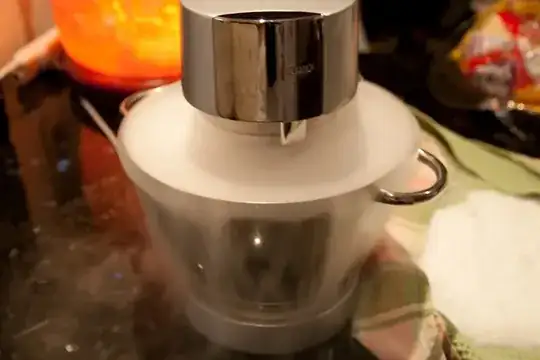I watched a restaurant documentary last night (Spinning Plates; pretty good!) which featured a modernist chef demonstrating their kitchen's anti-griddle: essentially a large metal plate chilled down to somewhere around -40 degrees (both F and C, oddly enough). It's used to chill and freeze foods that can't be frozen at normal freezer temperatures like olive oil, a bit like dipping or dropping into liquid nitrogen. I've never been much of a fan of molecular gastronomy, but I was absolutely fascinated by this idea, as I'd never seen anything like it before. I'm compelled to give it a try.
The official, professional version of this machine runs about $1200 USD, so that's completely out. These guys created one using a cast-iron skillet submerged in liquid nitrogen, but I'm not buying a massive container of that either. This site suggests that similar results can be had at home by placing a sheet pan on top of a block of dry ice, which sounds more reasonable, at least from a financial perspective. I obtained an estimate for a 10-inch x 10-inch x 2-inch slab of dry ice (about 10 lbs) for $15 USD. EDIT: Responses to date also suggest using a bed of dry ice chips. I'm checking to see if there's a significant price difference, as I'll probably be trying the cheapest method for my first go.
However, before I embark on what sounds like a chemistry lab demonstration in my kitchen, I thought it best to seek some advice. Specifically:
Has anyone actually tried this at home with any success? You'll get automatic bonus points for being braver than I.
Are there particular hazards that I need to be aware of during this exercise in applied insanity? Let's assume that I can guess at some obvious ones like "Don't touch the dry ice with your hands" and "Let the frozen items warm up a little before you eat them".
Would a slab the size of the one described above last long enough to let me experiment a bit, or would it simply sublimate down to a useless size within a matter of minutes?
If anyone's actually worked with a professional-grade anti-griddle before, would a home hack like this produce similar results, or am I just fooling myself?
I look forward to any input that I can get, because I'm really excited by the novelty of this idea! Feel free to completely dash my hopes.
EDIT: Great suggestions so far, thanks all! I'm keeping this open for now since I haven't seen any definitive answers based on experience with this method, and I'll add my own answer once I can give it a try.

